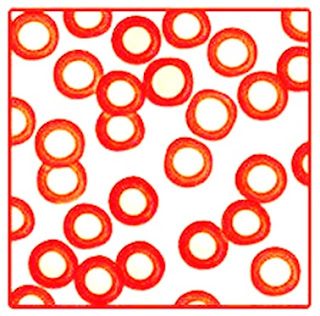Hypochromia - Symptoms, Causes, Treatment
Hypochromia is a typical condition in which the erythrocytes have less color than normal or original color. This is due to the less concentration of hemoglobin in the erythrocytes. It is also known as hypochromic anemia (historically known as chlorosis or green sickness) which is a condition having paler erythrocytes than normal. Normally erythrocytes have pallor region in the center of the cell but in diseased state the central pallor region increases and ultimately leads to less red color of cell due to lack of hemoglobin(the pigment which imparts color to cell).
Hypochromic anemia can also lead to the decrease in size of erythrocytes and this condition is defined as hypochromic microcytic anemia. In hypochromic microcytic anemia substantial overlap of red blood cells occur due to decrease in size and there are low number of working red blood cells. The size of cells decreases due to lack of hemoglobin (supply oxygen to the red blood cells)
Hypochromic microcytic anemia include:

The most common symptoms of hypochromic anemia are as follows:
Hypochromic anemia can also lead to the decrease in size of erythrocytes and this condition is defined as hypochromic microcytic anemia. In hypochromic microcytic anemia substantial overlap of red blood cells occur due to decrease in size and there are low number of working red blood cells. The size of cells decreases due to lack of hemoglobin (supply oxygen to the red blood cells)
Hypochromic microcytic anemia include:
- Iron deficiency anemia (due to iron deficiency on red blood cells)
- Thalassemia (inherited abnormality)
- Sideroblastic anemia (it can be inherited due to gene mutation or can be acquired. It impedes the body ability collect iron in one component of body)

Hypochromia Causes:
- Vitamin B6 deficiency is responsible or less intake of iron in body and it is also associated with low absorption of the minerals ultimately leads to hypochromic anemia.
- Any of the parasitic infection like hookworms can also lead to hypochromic anemia.
- Prescribed medicines can also be the cause of hypochromic anemia
- Lead poisoning is another leading cause of hypochromic anemia.
- The most common causes are Thalassemia and iron deficiency.
- Heavy periods in women and gastric bleeding due to ulcers can also cause hypochromic anemia.
- Inherited gene mutation (congenital) is another cause.
- Piles and hemorrhoids are another cause of this condition.
Hypochromia Symptoms:
The most common symptoms of hypochromic anemia are as follows:
- Clinical depression is often seen with this condition.
- Tachycardia occurs and the heart beat increases up to 100 beats per minute.
- Fatigue and tiredness occur due to less concentration of blood in body.
- Weakness is the major symptom of hypochromic anemia.
- It also disturb the sleep cycle
- Constipation can occur due to decreased circulation.
- Paleness of skin.
- Sore mouth shows the severity of disease.
- Menstrual cycle disturbs.
- Hypochromic anemia can lead to pica (a condition in which the patient feels craving or the non-food items like paper, paint, dirt etc.
Hypochromia Treatment:
- Carbonyl iron (an iron supplement usually prescribed for the deficiency of iron )
- Eculizumab is monoclonal antibody.
- Cyanocobalamin (vitamin b12) for treatment
- Darbepoetin alfa (erythropoiesis stimulating agent prescribed for anemia)
- Epoetin beta-methoxy polyethylene glycol (erythropoiesis stimulator).
- Homeopathic remedy cina is used or the hypochromic anemia treatment caused by the intestinal parasites.
- Ferrum met and ferrum phos are the bone marrow stimulating agents which produce the healthy Red blood cells.
- Smoking should be quit as it contains nicotine and caffeine responsible for less absorption of iron.
- The dietary fiber intake should be increased it will help to generate a healthy system.
Hypochromia - Symptoms, Causes, Treatment
 Reviewed by Simon Albert
on
September 09, 2017
Rating:
Reviewed by Simon Albert
on
September 09, 2017
Rating:
 Reviewed by Simon Albert
on
September 09, 2017
Rating:
Reviewed by Simon Albert
on
September 09, 2017
Rating:











